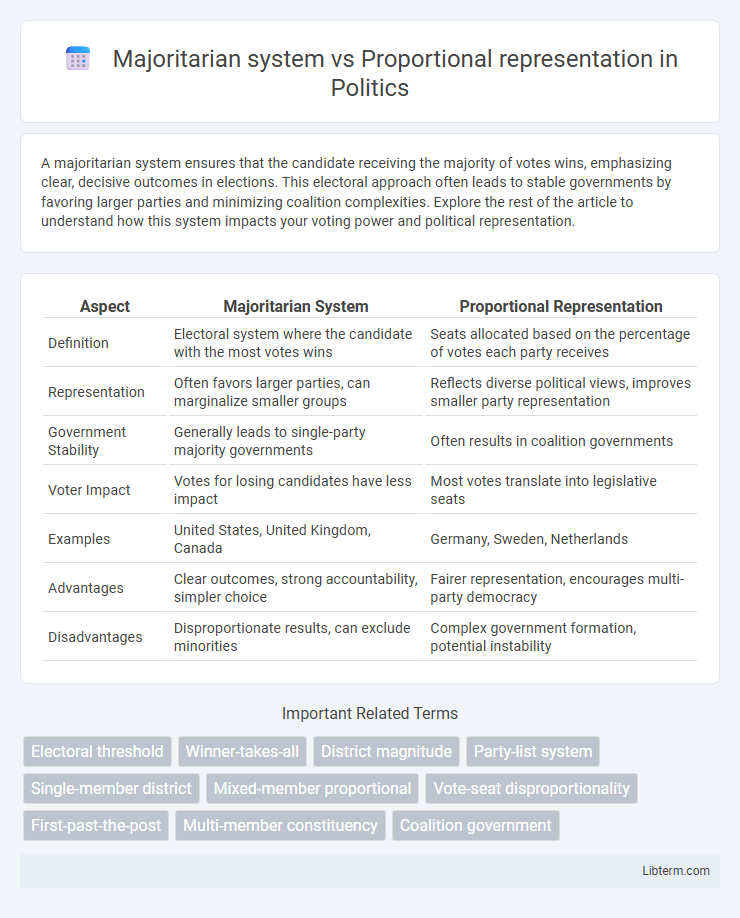A majoritarian system ensures that the candidate receiving the majority of votes wins, emphasizing clear, decisive outcomes in elections. This electoral approach often leads to stable governments by favoring larger parties and minimizing coalition complexities. Explore the rest of the article to understand how this system impacts your voting power and political representation.
Table of Comparison
| Aspect | Majoritarian System | Proportional Representation |
|---|---|---|
| Definition | Electoral system where the candidate with the most votes wins | Seats allocated based on the percentage of votes each party receives |
| Representation | Often favors larger parties, can marginalize smaller groups | Reflects diverse political views, improves smaller party representation |
| Government Stability | Generally leads to single-party majority governments | Often results in coalition governments |
| Voter Impact | Votes for losing candidates have less impact | Most votes translate into legislative seats |
| Examples | United States, United Kingdom, Canada | Germany, Sweden, Netherlands |
| Advantages | Clear outcomes, strong accountability, simpler choice | Fairer representation, encourages multi-party democracy |
| Disadvantages | Disproportionate results, can exclude minorities | Complex government formation, potential instability |
Introduction to Majoritarian and Proportional Representation
Majoritarian systems, often known as winner-takes-all, allocate legislative seats to candidates who receive the most votes in single-member districts, emphasizing clear local representation but potentially distorting overall vote-to-seat ratios. Proportional representation (PR) systems distribute seats according to the percentage of votes each party receives, promoting a multi-party landscape and better reflecting the electorate's diverse preferences. These fundamental differences impact electoral fairness, party dynamics, and government stability in democratic systems worldwide.
Key Principles of Majoritarian Systems
Majoritarian systems prioritize the candidate or party receiving the most votes, typically through single-member districts, ensuring clear majority control and decisive governance. This system emphasizes direct voter accountability and the formation of strong, stable governments by producing clear winners in elections. Key principles include the winner-takes-all approach, simple plurality or absolute majority thresholds, and the goal of effective representation through geographic constituencies.
Core Features of Proportional Representation
Proportional representation (PR) allocates legislative seats in direct proportion to the percentage of votes each party receives, ensuring minority groups and smaller parties gain fair representation. This system often employs multi-member districts and party lists to reflect voter preferences accurately, enhancing political diversity and inclusivity. PR reduces wasted votes, encourages coalition governments, and tends to increase voter turnout by promoting equitable competition among parties.
Historical Origins and Development
The Majoritarian system, rooted in British parliamentary traditions, emerged during the 19th century as a method to ensure stable single-party governments, emphasizing winner-takes-all outcomes. Proportional representation originated in the late 19th and early 20th centuries in Europe, particularly in Belgium and Sweden, aiming to reflect the diverse political preferences of the electorate more accurately. Over time, majoritarian systems dominated former British colonies, while proportional representation gained traction in continental Europe, shaping distinct democratic governance models globally.
Advantages of Majoritarian Systems
Majoritarian systems offer the advantage of producing clear and stable governments by awarding seats to candidates who secure the most votes in single-member districts, often resulting in a strong link between representatives and constituents. This system tends to simplify voter choice and accountability by promoting a two-party structure, which can lead to decisive policymaking and reduced political fragmentation. Furthermore, majoritarian systems often exclude extremist parties, fostering moderate political discourse and more predictable legislative outcomes.
Advantages of Proportional Representation
Proportional representation ensures that political parties gain seats in proportion to the votes they receive, promoting fairer and more accurate representation of diverse political views. This system enhances minority representation and reduces wasted votes, contributing to higher voter engagement and legitimacy. Countries like Germany and New Zealand employ proportional representation, leading to multi-party cooperation and greater policy inclusiveness.
Common Criticisms of Majoritarian Voting
Majoritarian voting systems often face criticism for underrepresenting smaller political parties and minority groups, leading to a lack of diverse viewpoints in legislatures. This system tends to produce disproportional outcomes where the winning party secures a majority of seats without a majority of votes, resulting in skewed political power. Critics argue that majoritarian systems can exacerbate regional divisions and contribute to voter disenfranchisement due to the "winner-takes-all" nature.
Critiques of Proportional Representation
Proportional representation often faces criticism for enabling fragmented legislatures where numerous small parties struggle to form stable governments, leading to frequent coalitions and potential political gridlock. Critics argue this system can dilute accountability, as voters find it harder to associate specific policy outcomes with individual parties or candidates. Furthermore, proportional representation may empower fringe parties with minimal support, skewing policymaking away from broad national consensus.
Impact on Political Parties and Governance
The majoritarian system often consolidates power among a few dominant political parties, promoting stable governments but limiting smaller party representation. Proportional representation encourages multi-party systems by allocating seats based on vote share, enhancing diversity and inclusive governance but sometimes leading to fragmented parliaments and coalition complexity. These differences shape political competition, party strategies, and the overall effectiveness of legislative decision-making.
Global Examples and Case Studies
The Majoritarian electoral system, exemplified by the United States and the United Kingdom, tends to produce single-party dominant governments, simplifying governance but often marginalizing smaller parties. Proportional representation, used in countries like Germany and the Netherlands, ensures broader political diversity by allocating seats based on the percentage of votes each party receives, fostering coalition governments. Comparative case studies reveal that Majoritarian systems often prioritize stability and decisiveness, whereas Proportional representation enhances inclusivity and minority representation.
Majoritarian system Infographic

 libterm.com
libterm.com